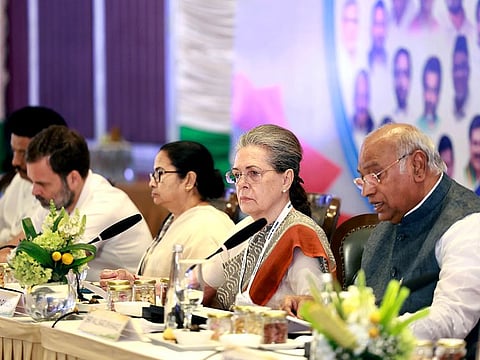INDIA alliance meet in Mumbai: Opposition needs to declare a formula for its PM candidate
The political block must put and end to the PM question and focus on campaigning

Anyone who thinks the Indian National Developmental Inclusive Alliance, or “INDIA”, can actually form the next national government, is living in a fool’s paradise.
And yet, each one of the 543 seats in the Lok Sabha matters. The scale of the BJP’s almost-certain victory and the scale of the opposition’s defeat matter for both the short-term and long-term future of Indian politics.
People elect not just a government but also an opposition. A strong opposition is key to a healthy democracy. The 2024 Lok Sabha election is not about who will win but about whether the Indian voter will provide a better balance between power and dissent.
This is why the INDIA alliance matters, and why it must fight to win. To this end, its biggest stumbling block will be the PM candidate question.
A reporter asked an Aam Aadmi Party (AAP) spokesperson who would be the Prime Ministerial candidate of the INDIA alliance. The spokesperson replied that she would like to see AAP’s Arvind Kejriwal as the candidate. The AAP had to make a minister contradict the statement and say he was not in the PM race.
The media and the ruling BJP will keep asking this question. It is the weakest point of the INDIA alliance and the strongest point of the BJP. Prime Minister Narendra Modi’s popularity is what the BJP’s edifice today rests on.
Addressing the weakness
You don’t play on your weak points. You play on your strong points. The INDIA alliance therefore need not declare a PM candidate. Yet, by not doing so, it keeps the issue alive. Every day we will hear the question: but who’s your PM candidate? Who’s your face? Who’s your leader? Who’s the one person in whose hands you want to give the keys to the nation? Rahul Gandhi? Mallikarjun Kharge? Nitish Kumar? Arvind Kejriwal?
Therefore it is important for the INDIA alliance to have a good answer that puts an end to the question. If this question is a distraction from the INDIA alliance’s strong points, then this distraction needs to be put to rest.
It would therefore be a good idea for the INDIA alliance to take the bull by the horns and give a clear answer to the PM candidate question. To say that we are a parliamentary democracy and elected MPs will decide, is not good enough.
It sounds wishy-washy. And it’s a lie. Everyone knows it wasn’t Congress MPs but Sonia Gandhi who decided Manmohan Singh would be prime minister.
More importantly, we-will-see-later raises the spectre of an unstable coalition, further driving voters to the stability the BJP provides. Who wants to go back to the days when elections used to be held every two years?
A one-line formula
A better answer would perhaps be to say that the party that gets the best strike rate will have its leader as prime minister. This will rule out the Congress, as regional parties will have a better chance. The Congress should not worry about this — they’re not coming anywhere near government formation anyway.
This will foster some sense of completion among regional parties — some 27 of them — which will try to focus on winning more seats than contesting more seats. Regional leaders like Nitish Kumar might even dream of becoming prime minister, thus giving their best to to Lok Sabha election.
If not this, then some reasonable, persuasive ‘formula’ should be given to explain how the INDIA alliance will elect its prime minister after winning the election. This should be done to serve the limited purpose of ending the who-will-be-PM question.
The strong wicket
That brings us to the question, what are the strong points on which the INDIA alliance must play? That’s a no-brainer. Every survey tells you that the sticking point for the BJP is inflation and unemployment.
Yet you see opposition parties willing to bring the Parliament to a halt over Adani and Manipur, never over inflation, unemployment, or welfare issues.
The insecurity of gig workers, the need for an urban job guarantee programme, the need to reduce LPG refills or to incentivise job-creating industries don’t seem to be front and centre in the speeches of opposition leaders.
In other words, the INDIA alliance may not have a face, but it can have a good narrative. This may not be enough to win but it can help increase seats.
Other than the face and narrative, there is one more element that an election needs. That element is the carriage of the narrative to the masses, known by the word campaign.
Need for speed
If the INDIA alliance meets once a month it’s not going to be able to carry a message to 950 million (95 crore) Indians in the next 7-8 months.
The INDIA alliance thus needs to decide its message, its narrative, and its common minimum programme and immediately launch Yatras across India to take the message to the masses. These Yatras should not be marches on foot but on buses, maximising not the kilometres travelled but the number of people addressed in gatherings small and large.
To make this happen, and happen with the sense of urgency it needs, the ball will ultimately be in the court of the Gandhi family. Can they surprise us with that one thing they are not known for, speed?
Sign up for the Daily Briefing
Get the latest news and updates straight to your inbox




